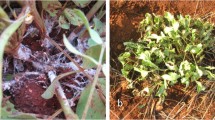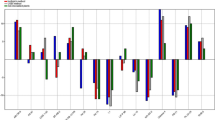Abstract
During the survey and monitoring, a disease affecting sugarcane arrows was noticed. Sugarcane inflorescence with symptoms was collected from the germplasm maintained at ICAR-SBIRC, Kannur. The disease was observed in 2017, 2018 and 2021. The length of affected grains varied from 3 to 3.5 mm, an average of 3.2 mm and the width varied from 1 to 1.5 mm, while regular grains showed no change in length, and the width was only 0.5 mm. The affected grains were somewhat bulged and black. Conidia of Epicoccum andropogonis and Claviceps purpurea were observed when examined under a light microscope, whereas, in culturing, the affected grains yielded only E. andropogonis. The morphological characteristics of E. andropogonis were studied in vitro. The shape, color and size of the fungus conidia resembled the conidia in vitro culture media. This fungus was identified based on molecular data from the ITS-rDNA sequence, and this is the first report of false floral smut occurrence on germplasm maintained at SBIRC, Kannur. A total of 24 clones were affected, including a clone WL 08-259 of waterlogging trial in 2021. The clones were categorized based on the number of spikelets affected. All the Saccharum species clones, 287 foreign hybrids and 393 Indian hybrids clones were found to be resistant. The 18 clones of Indian hybrids and two foreign hybrids were found to be highly susceptible, and three clones of Indian hybrids were moderately susceptible.






Similar content being viewed by others
References
Bandyopadhyay, R., D.E. Frederickson, N.W. McLaren, G.N. Odvody, and M.J. Ryley. 1998. Ergot: A new disease threat to sorghum in the Americas and Australia. Plant Disease 82: 356–367.
Bhuiyan, S.A., M.J. Ryley, V.J. Galea, et al. 2009. Effects of conidial concentration and stigma wetness period on infection by the sorghum ergot pathogen Clavicepsafricana. Australasian Plant Pathology 38: 496–499.
Blaney, B.J., R.A. McKenzie, J.R. Walters, L.F. Taylor, W.S. Bewg, M.J. Ryley, and R. Maryam. 2000. Sorghum ergot (Clavicepsafricana) associated with agalactia and feed refusal in pigs and dairy cattle. Australian Veterinary Journal 78: 102–107.
Bové, F.J. 1970. The story of ergot, 134–165. Basle: S. Karger.
Frederickson D.E, and Obilana, A.B. 1993. Manipulating the hybrid production system to control ergot (Claviceps africana). Page 1 in ICRISAT Southern and Eastern Africa Regional Program Annual Report 1993. Southern African Development Community/International Crops Research Institute for the Semi-Arid Tropics, Sorghum and Millet Improvement Prog., Bulawayo, Zimbabwe.
Gopi, R., R. Viswanathan, K. Chandran, M. Nisha, B. Mahendran, Maya Lekshmi, and P.P. Girisan. 2020. Distribution scenario of diseases in sugarcane germplasm at Kannur, Kerala. Journal of Sugarcane Research 10 (2): 186–197.
Hart, C. 1999. Forged in St. Anthony’s fire: Drugs for migraine. Modern Drug Discovery 2: 20–31.
Miedaner, T., and H.H. Geiger. 2015. Biology, genetics, and management of ergot (Claviceps spp.) in rye, sorghum, and pearl millet. Toxins (basel) 7 (3): 659–678.
Mitchell, D.T., and R.C. Cooke. 1968. Some effects of temperature on germination and longevity of sclerotia in Clavicepspupurea. TraNsactions of the British Mycological Society 51: 721–729.
Rad, S.H., L. Ebrahimi, and S. Shabazi. 2019. First record of Epicoccumandropogonis growing on Paspalumdilatatum ergot in Iran. Mycologia Iranica 6 (1): 49–54.
Rott P., A. Bailey, C. Roger, J.J. Comstock, J. Croft Barry, and A. Saumtally Salem. 2000. A guide to sugarcane diseases, 339. Montpellier: CIRAD.
Singh, S. 1976. Occurrence of ergot and false smut on Saccharumspontaneum in India. Journal of Plant Disease and Protection 83 (7/8): 442–447.
Tenberge, K.B. 1999. Biology and life strategy of the ergot fungi. In Ergot—the genus Claviceps, ed. Køen, V., and L. Cvak, 25–56. Amsterdam: Harwood Academic Publishers.
The Economic Survey of India 2021–2022. The Finance Ministry, Govt. of India. pp 498.
Viswanathan, R. 2012. Molecular basis of red rot resistance in sugarcane. Functional Plant Science and Biotechnology 6 (2): 40–50.
Viswanathan, R., and N.M.R. Ashwin. 2020. Brown spot of sugarcane: An emerging disease in south western region in India. Journal of Sugarcane Research 10: 87–93.
Yadav, M.K., P.K. Dhakad, S.K. Yadav, S. Naik, and R. Chandra. 2016. A Treatise on sugarcane diseases in North India. Advances in Life Sciences 5 (11): 4363–4371.
Acknowledgements
We immensely thank Director, ICAR-Sugarcane Breeding Institute, Coimbatore, for the help in conducting the research and also technicians and supporting staff of ICAR-SBIRC, Kannur, Kerala.
Author information
Authors and Affiliations
Corresponding author
Ethics declarations
Conflict of interest
The authors do not have any conflict of interest with respect to the research and manuscript.
Additional information
Publisher's Note
Springer Nature remains neutral with regard to jurisdictional claims in published maps and institutional affiliations.
Rights and permissions
Springer Nature or its licensor (e.g. a society or other partner) holds exclusive rights to this article under a publishing agreement with the author(s) or other rightsholder(s); author self-archiving of the accepted manuscript version of this article is solely governed by the terms of such publishing agreement and applicable law.
About this article
Cite this article
Gopi, R., Chandran, K., Ramesh Sundar, A. et al. Occurrence of False Floral Smut in Sugarcane Inflorescence and Associated Weather Variables. Sugar Tech 25, 1411–1418 (2023). https://doi.org/10.1007/s12355-023-01304-w
Received:
Accepted:
Published:
Issue Date:
DOI: https://doi.org/10.1007/s12355-023-01304-w




